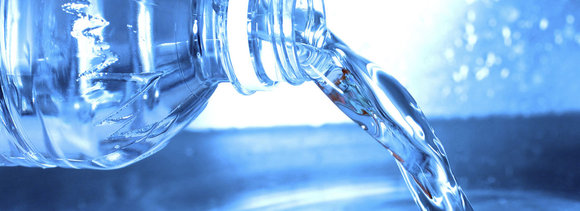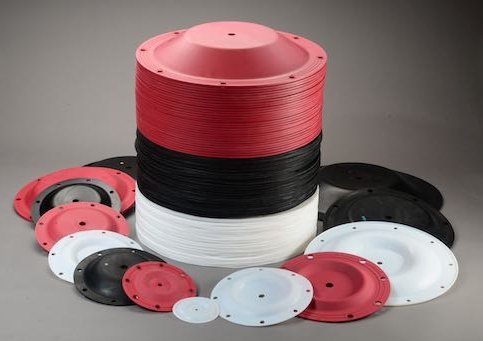Diaphragms separate air and liquid chambers of an AODD (Air Operated Double Diaphragm) Pump. Failure of diaphragm will not only stop the pump operation but also result in leakage of the process fluid (with related spillage issues). It is imperative right diaphragms are selected for trouble-free, reliable, and safe pump operation. In this blog, we will discuss more about the factors to consider for diaphragm selection, material options available, and recommendations for general applications.
Factors to Consider for Diaphragm Selection
1. Prior Experience: Good starting point is prior experience of handling diaphragms materials against the liquid pumped.
2. Chemical Compatibility: Each liquid is unique and chemical compatibility is must. It is also important that diaphragms are compatible with non-process liquids as well (such as cleaning agents etc).
Most pump manufacturers publish detail chemical compatibility charts with respect to diaphragm materials options. Here is a useful link:
http://www.sandpiperpump.com/sites/sandpiperpump.com/files/documents/spchem_lr.pdf
If in doubt, always consult your process personnel to ensure that diaphragms selected are compatible with the liquid pumped.
3. Abrasion Resistance: An abrasive liquid contains substances, often minerals and inorganic materials, that are harder than the material they rub against. This abrasion will wear out and damage softer materials, such as diaphragms. There are diaphragms available to handle such abrasive liquids.
4. Flex Life: How long will the diaphragms last? Pump may cycle hundred times in a minute. Diaphragm has to flex with each stroke. Some diaphragm materials have longer flex life than others even under same ideal operating conditions, meaning these can cycle more without losing mechanical properties. Diaphragms will need to be replaced after its flex life is over.
5. Temperature: Operating temperature of the process fluid is an important consideration for diaphragm selection. At high temperatures, some materials can disintegrate and may not have same corrosion resistance (compared to lower temperatures). At lower temperatures, diaphragm flexibility is usually an issue. Each diaphragm materials has a range of working temperature. Of course, maximum flex life can’t be expected as you operate the pump at the extreme limits of the temperature ranges.
6.Suction Condition: Since AODD pumps are self-priming, the application can be flooded suction or suction lift. Be careful about such system parameters for diaphragm selection.
7. Hygienic Applications: For pumps used in food, beverages, dairy, personal care, and pharmaceutical industries, diaphragms must meet hygienic industry standards such US FDA (Food & Drug Administration) and US Pharmacopeia Convention (USP) standards.
8. Cost: Each diaphragm material comes at different cost. Total cost of ownership of diaphragm is determined by various factors such as initial purchase cost, flex life, cost of downtime, labor costs for replacing the diaphragms etc.
Over the years, a number of materials have been tested extensively for use in diaphragms in AODD pumps. We now list commonly used diaphragm materials along with their properties, and provide guidelines for application usage.
|
Material |
Remarks |
Temp range |
Recommended for |
Beware List |
|
Nitrile (Buna-N) |
Rubber type. General purpose, oil resistant. Moderate flex life and abrasion resistance |
-230C to 880C -100F to 1900F |
Hydrocarbons (fuels, oils), water, hydraulic fluids, solvents. Version available for food industry |
Highly polar solvents (ketones, acetone, ozone, chlorinated & nitro hydrocarbons) |
|
FKM (VitonTM) |
Rubber type. Moderate flex life and abrasion resistance |
-400C to 1770C -400F to 3500F |
Extremely good for high temperature, aggressive chemicals (strong chlorinated hydrocarbons), animal and vegetable oils |
Hot water or hot aqueous solutions (>20 0C) |
|
Neoprene |
Rubber type. All purpose, oil resistant. Good flex life and abrasion resistance |
-230C to 930C -100F to 2000F |
Water, Non-aggressive chemicals, water based slurries |
Strong oxidizing acids, ketones, esters, nitro and aromatic hydrocarbons |
|
EPDM |
Rubber type. Good flex life and moderate abrasion resistance |
-400C to 1380C -400F to 2800F |
Good water resistance and diluted chemicals. Version available for food industry |
Oils/ Solvents |
|
SantopreneTM |
Injection molded thermoplastic type. Long flex life & excellent abrasion resistance |
-400C to 1350C -400F to 2700F |
Acidic & Caustic fluids (sulfuric acid, HCl), Water based slurries, Chemicals |
Aggressive chemicals |
|
Urethane |
Injection molded thermoplastic type. Good flex life & abrasion resistance |
00C to 660C -320F to 1500F |
Water, wastewater, sea water |
Aggressive chemicals |
|
Polytetrafluoro-ethylene (PTFE) |
Thermoplastic type. Long flex life & moderate abrasion resistance. Back up diaphragm is required as PTFE is non-elastic |
-370C to 1040C -350F to 2200F |
Chemically inert, virtually impervious. Paints, Inks, Coatings, Solvents, Aromatics, Ketones, Acetates, Esters, Version available for food/ pharma industry |
Molten alkali metals, few fluoro-chemicals at high temp |
In conclusion, selecting right diaphragm for any applications requires considerations of several factors such as operating temperature, abrasive nature, chemical compatibility, flex life, suction conditions, and cost. Different diaphragm materials exhibit different performance on these factors, so it is important to get expert advice. With proper diaphragm selection, you will get safe, efficient, cost effective, and trouble free pump operation.
Notes: VitonTM is registered trade mark of DuPont company. SantopreneTM is registered trade mark of ExxonMobil.

